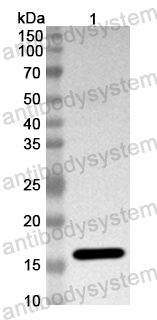Catalog No.
PMF97801
Species reactivity
Mouse
Host species
Rabbit
Isotype
IgG
Clonality
Polyclonal
Immunogen
E. coli - derived recombinant Mouse MECOM (Asp74-Ser193).
Tested applications
ELISA: 1:4000-1:8000, IHC: 1:50-1:100, WB: 1:1000-1:4000
Target
Histone-lysine N-methyltransferase MECOM, 2.1.1.367, Ecotropic virus integration site 1 protein, EVI-1, MDS1 and EVI1 complex locus protein, Myelodysplasia syndrome 1 protein homolog, Mecom, Evi1, Mds1, Prdm3
Purification
Purified by antigen affinity column.
Accession
P14404
Applications
ELISA, IHC, WB
Form
Liquid
Storage buffer
0.01M PBS, pH 7.4, 50% Glycerol, 0.05% Proclin 300.
Stability and Storage
Use a manual defrost freezer and avoid repeated freeze thaw cycles. Store at 2 to 8°C for frequent use. Store at -20 to -80°C for twelve months from the date of receipt.
Therapeutic horizon of acute myeloid leukemia: Success, optimism, and challenges., PMID:40105906
The ETV6-MECOM fusion protein promotes EMT-related properties by repressing the transactivation activity of E-cadherin promoter in K562 leukemia cells., PMID:38405662
Molecular Classification and Overcoming Therapy Resistance for Acute Myeloid Leukemia with Adverse Genetic Factors., PMID:35682627
The EDA-deficient mouse has Zymbal's gland hypoplasia and acute otitis externa., PMID:35107126
Identification of loci associated with susceptibility to bovine paratuberculosis and with the dysregulation of the MECOM, eEF1A2, and U1 spliceosomal RNA expression., PMID:33432064
EVI1 carboxy-terminal phosphorylation is ATM-mediated and sustains transcriptional modulation and self-renewal via enhanced CtBP1 association., PMID:29939287
Persistent polyclonal binucleated B-cell lymphocytosis and MECOM gene amplification., PMID:26935937
EVI1 promotes tumor growth via transcriptional repression of MS4A3., PMID:25886616
Induction of the proapoptotic tumor suppressor gene Cell Adhesion Molecule 1 by chemotherapeutic agents is repressed in therapy resistant acute myeloid leukemia., PMID:25491945
Transcription factors involved in prostate gland adaptation to androgen deprivation., PMID:24886974
SUMO1 negatively regulates the transcriptional activity of EVI1 and significantly increases its co-localization with EVI1 after treatment with arsenic trioxide., PMID:23770046
EVI-1 modulates leukemogenic potential and apoptosis sensitivity in human acute lymphoblastic leukemia., PMID:22828445
The increased expression of integrin α6 (ITGA6) enhances drug resistance in EVI1(high) leukemia., PMID:22295105
Biphasic and dosage-dependent regulation of osteoclastogenesis by β-catenin., PMID:21876000
CD52 as a molecular target for immunotherapy to treat acute myeloid leukemia with high EVI1 expression., PMID:21394097
Acetylation of lysine 564 adjacent to the C-terminal binding protein-binding motif in EVI1 is crucial for transcriptional activation of GATA2., PMID:20363750
Zfp521 antagonizes Runx2, delays osteoblast differentiation in vitro, and promotes bone formation in vivo., PMID:19095088
SnoN overexpression is predictive of poor survival in patients with esophageal squamous cell carcinoma., PMID:18612694
Repression of RUNX1 activity by EVI1: a new role of EVI1 in leukemogenesis., PMID:17575132
Expression of transcription factors during megakaryocytic differentiation of CD34+ cells from human cord blood induced by thrombopoietin., PMID:11286316
Phenotyping of Evi1, Evi11/Cb2, and Evi12 transformed leukemias isolated from a novel panel of cas-Br-M murine leukemia virus-infected mice., PMID:10704339
Ecotropic viral integration site-1 is activated during, and is sufficient for, neuroectodermal P19 cell differentiation., PMID:10470856
The AML1/ETO(MTG8) and AML1/Evi-1 leukemia-associated chimeric oncoproteins accumulate PEBP2beta(CBFbeta) in the nucleus more efficiently than wild-type AML1., PMID:9473235

